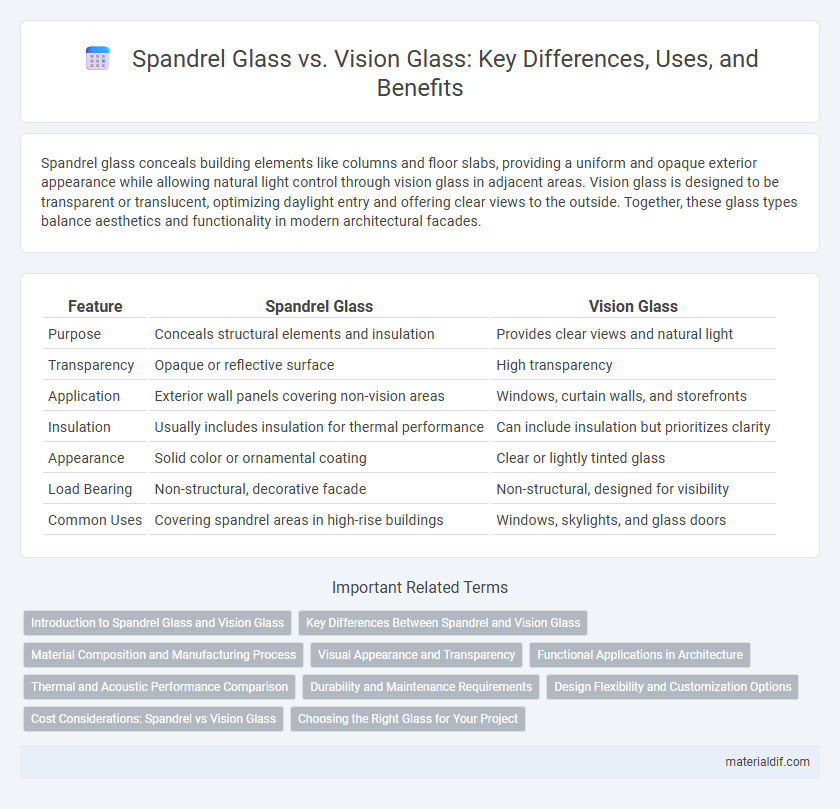Spandrel glass conceals building elements like columns and floor slabs, providing a uniform and opaque exterior appearance while allowing natural light control through vision glass in adjacent areas. Vision glass is designed to be transparent or translucent, optimizing daylight entry and offering clear views to the outside. Together, these glass types balance aesthetics and functionality in modern architectural facades.
Table of Comparison
| Feature | Spandrel Glass | Vision Glass |
|---|---|---|
| Purpose | Conceals structural elements and insulation | Provides clear views and natural light |
| Transparency | Opaque or reflective surface | High transparency |
| Application | Exterior wall panels covering non-vision areas | Windows, curtain walls, and storefronts |
| Insulation | Usually includes insulation for thermal performance | Can include insulation but prioritizes clarity |
| Appearance | Solid color or ornamental coating | Clear or lightly tinted glass |
| Load Bearing | Non-structural, decorative facade | Non-structural, designed for visibility |
| Common Uses | Covering spandrel areas in high-rise buildings | Windows, skylights, and glass doors |
Introduction to Spandrel Glass and Vision Glass
Spandrel glass is a type of opaque or translucent glass used to conceal structural elements, insulation, and mechanical components in building facades, enhancing aesthetic appeal while providing uniform appearance. Vision glass, in contrast, is transparent or lightly tinted glass designed to maximize natural light penetration and provide clear views outside. Both types of glass play crucial roles in architectural design by balancing functionality, aesthetics, and energy efficiency in modern building envelopes.
Key Differences Between Spandrel and Vision Glass
Spandrel glass is opaque and used to conceal structural elements, insulation, or mechanical systems behind a building's facade, whereas vision glass is transparent to allow natural light and visibility. Spandrel glass often features coatings or ceramic frits to provide color and opacity, while vision glass is typically treated for clarity, UV protection, and energy efficiency. The primary difference lies in their function: spandrel glass enhances architectural aesthetics and privacy, while vision glass maximizes daylight and external views.
Material Composition and Manufacturing Process
Spandrel glass is composed of an opaque substrate, typically a tempered glass panel coated with ceramic frit or painted on the back, designed to conceal building elements like insulation and structural components. Vision glass, in contrast, is transparent or translucent, made from annealed, tempered, or laminated clear glass that allows natural light transmission and unobstructed views. The manufacturing process for spandrel glass involves additional coating or back-painting steps to achieve opacity, while vision glass undergoes treatments to enhance clarity, strength, and environmental performance without altering transparency.
Visual Appearance and Transparency
Spandrel glass features an opaque finish that conceals building elements such as structural frames or insulation, offering a uniform visual appearance without transparency. Vision glass, in contrast, provides clear, transparent views, allowing natural light to penetrate interior spaces and enabling occupants to see outside. The choice between spandrel and vision glass significantly impacts a building's facade aesthetics and daylighting performance.
Functional Applications in Architecture
Spandrel glass is primarily used to conceal structural elements, insulation, and mechanical systems in building facades while maintaining a consistent exterior appearance, thereby enhancing thermal performance and aesthetic uniformity. Vision glass offers transparent or tinted glazing that allows natural light penetration and unobstructed views, improving occupant comfort and energy efficiency through daylighting. Both types serve distinct functional roles in architectural design, with spandrel glass contributing to facade concealment and insulation, and vision glass facilitating visual connection and interior illumination.
Thermal and Acoustic Performance Comparison
Spandrel glass offers superior thermal insulation due to its opaque layers that reduce heat transfer, making it ideal for energy-efficient building envelopes. Vision glass, while providing transparency and natural daylight, typically exhibits higher thermal conductivity and lower acoustic attenuation. The choice between spandrel and vision glass significantly impacts building performance, with spandrel glass enhancing energy efficiency and noise reduction more effectively.
Durability and Maintenance Requirements
Spandrel glass offers enhanced durability due to its opaque coating that protects against weathering and structural damage, making it ideal for building facades requiring low maintenance. Vision glass, designed for transparency and light transmission, often includes treatments to improve strength but typically demands more frequent cleaning to maintain clarity and aesthetic appeal. Both types benefit from tempered or laminated construction to increase impact resistance, yet spandrel glass generally requires less upkeep over time because its surface conceals dirt and imperfections.
Design Flexibility and Customization Options
Spandrel glass offers enhanced design flexibility and extensive customization options, allowing architects to conceal structural elements and achieve seamless facade aesthetics without compromising natural light. Vision glass prioritizes transparency and clarity, providing clear views and daylighting while offering limited color and texture variations. Selecting between spandrel and vision glass depends on the balance required between facade design creativity and natural illumination needs.
Cost Considerations: Spandrel vs Vision Glass
Spandrel glass typically costs less than vision glass due to its opaque nature and simpler manufacturing processes, making it a cost-effective option for concealing structural elements and mechanical systems. Vision glass, designed for transparency and clarity, involves higher production expenses and optional coatings for solar control or safety, increasing its overall price. When budgeting, spandrel glass offers significant savings in non-visual areas, whereas vision glass requires a greater investment for aesthetic and functional glazing.
Choosing the Right Glass for Your Project
Spandrel glass, designed to conceal structural elements and provide aesthetic uniformity on building facades, is opaque and often used to mask insulation or mechanical components. Vision glass, transparent and typically low-emissivity, maximizes natural light penetration and offers clear views while improving energy efficiency through advanced coatings. Selecting the right glass depends on the project's functional requirements, such as privacy needs or daylighting goals, and factors in thermal performance, aesthetics, and budget constraints.
Spandrel Glass vs Vision Glass Infographic

 materialdif.com
materialdif.com